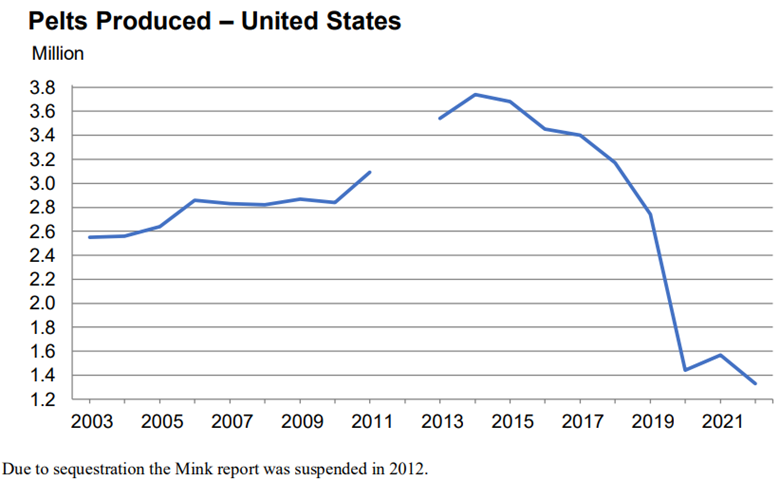By Sara Amundson and Kitty Block
Fur production in the U.S. is plummeting, and that’s good news for animals. Every five years, as part of the U.S. Census, the U.S. Department of Agriculture releases data on mink farms in the country. The newly released numbers show that in 2017, 236 mink fur farms existed in the U.S. Five years later, only 110 mink fur farms remained. With the speed of this decline, we believe even more mink farms have closed in the last year.
During that same time period, the number of mink killed for their fur in the U.S. has declined from 3.3 million to 1.3 million. Paired with the low prices mink fur farmers are receiving for those pelts, the value of the U.S. mink trade has dropped 68% from $123 million in 2017 to $39 million in 2022.

As a semi-aquatic species, wild mink depend on natural bodies of water to survive. In the fur industry, every instinct they have, like swimming and fishing, is thwarted. They are bred just to languish in small wire cages until they get big enough to be skinned, at which point they are suffocated to death by gas to ensure their pelts remain intact and can fetch a higher price tag.
The new numbers show an enormous drop in demand, meaning millions of mink are spared from suffering and death, all to produce poms on hats or fur-trim on gloves and shoes. This is thanks in no small part due to growing awareness about the inherent cruelties and public health dangers of the fur industry.
Over the past several years, mink on nearly 500 fur farms across 13 countries, and in the U.S. across four states (Wisconsin, Oregon, Utah and Michigan), have tested positive for COVID-19. Because of the filth and way these undomesticated animals are packed so closely together, fur farms act as vectors for zoonotic diseases, allowing them to mutate and then spread to humans and wildlife. In Utah, wild mink in vicinity of fur farms have been infected with a variant of SARS-CoV-2 found in farmed mink. And now, fur-farmed mink are testing positive for the highly pathogenic avian influenza, sparking similar concerns over the potential transmission of the disease to humans.
The level of disease risk for the sake of fur fashion simply cannot be justified, which is why last year U.S. Rep. Adriano Espaillat introduced the Mink: Vectors for Infection Risk in the United States Act, known as the ‘‘Mink VIRUS Act,” a bipartisan bill that seeks to prohibit the farming of mink in the U.S. The disease risk that farming mink for their fur also led us, alongside coalition partners, to petition the U.S. Fish and Wildlife Service to list American mink as “injurious” under the Lacey Act. This petition is still under consideration by the agency, but if granted this listing would prohibit U.S. importation, transportation and acquisition of live and dead mink, including parts containing fur. Fur farming has already been banned in 20 countries, and we hope more countries follow this trend.
As the mink trade dwindles, so does the rest of the fur industry. There is no doubt that the fur trade’s days are numbered. Still, there is work to be done. While we know fox fur farms exist in the U.S., the USDA does not track them, meaning they are completely unregulated, and it’s impossible to know how many there are in the country. Further, U.S. fur farmers are still hoping that major fur buyers from Russia and China will eventually save them by importing pelts from U.S. fur farms. The reality they have yet to face is that the demand for fur products will continue to decline globally with more brands and retailers shunning fur and more cities, states and countries banning fur sales. Fur farmers around the globe should start transitioning to other trades that don’t rely on animal cruelty and pose a significant risk to public health. It’s becoming increasingly clear that a pom on a hat or trim on a coat just isn’t worth it.
You can be fashion-forward by signing the pledge to go fur-free. You can also make a donation to our work to end cruelties toward animals.
Kitty Block is CEO of the Humane Society of the United States.



